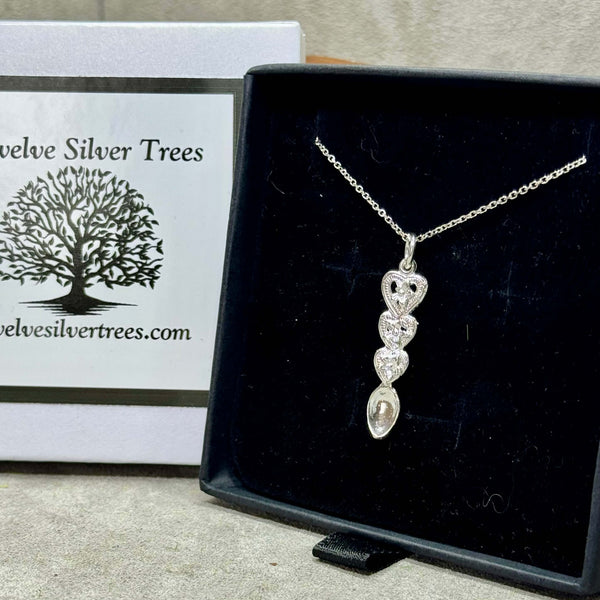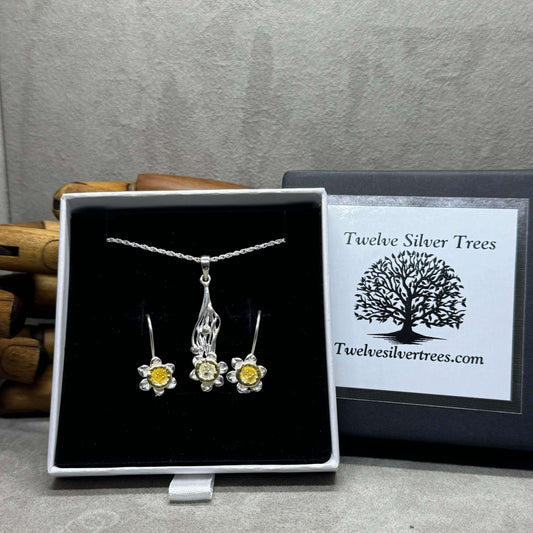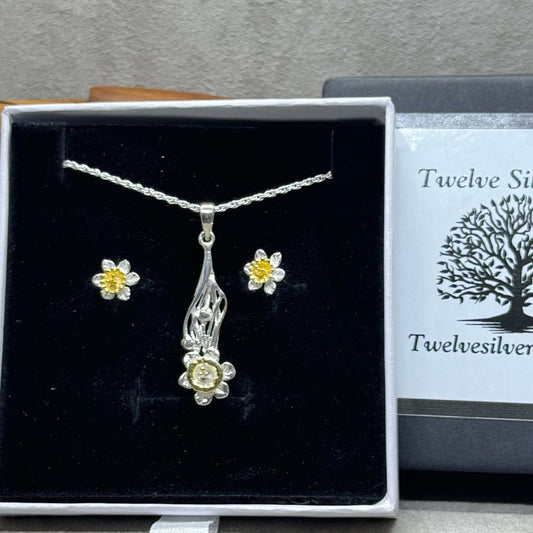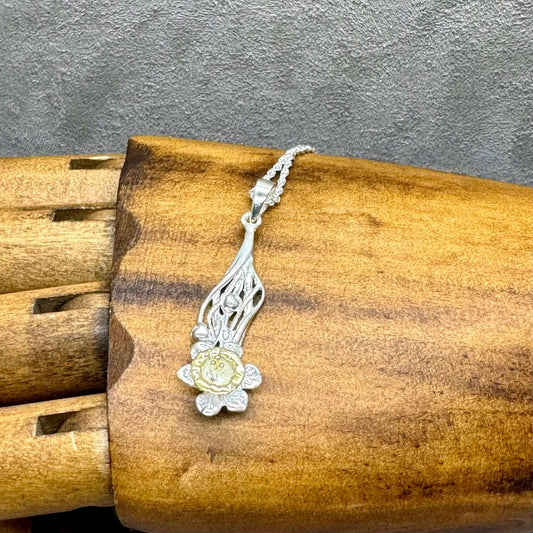
Hidden Symbolism - The Daffodil In Jewellery
Share
The vibrant Daffodil is the ultimate spring flower, strong little things that manage to survive winter and are ready to grow & bloom as soon as the days start getting longer. Symbolising rebirth, hope, joy and resilience there is so much to learn about this spring favourite.
Daffodils have a long history behind them, going back to at least 300BC. Theophrastus, the Greek botanist and philosopher was one of the first people to describe the flower in his notes. The Roman army introduced the daffodil to most of the world, including England, as they believed the sap had healing powers. In actual fact, the sap can irritate the skin but we are glad they shared the flower with the world anyway.
The daffodil was one of Shakespeare’s favourite flowers & Flower girls in the 17th century would sell bunches of of handpicked wild blooms on the streets of market towns & cities and by the 19th century the farming of daffodils for cut-flowers began.
How did the daffodil get its name?
All daffodils are members of the narcissus plant family. Some people find this a little confusing as the daffodil is the official name for any of the plants in the narcissus. Basically, if a plant is considered to be a narcissus, it will be considered as a daffodil too.
In Greek mythology narcissus was the son of a river god. Narcissus was a strong hunter known for his beauty but he was egotistical & incredibly arrogant about it. After a water nymph fell in love and was rejected by him, Nemesis, the Goddess of revenge, took matters into her own hands and lured him to a pool where he fell in love with his own reflection and gazed at himself for the rest of his life. Some say that the nymphs turned him into a flower while he was admiring himself. But, others think he fell into the pool while trying to capture his reflection and drowned, the flowers that then grew along the riverbed were named after him. This flower is now known as Narcissus.
It’s a little more unclear on where the name ‘daffodil’ came from. The daffodil’s common name first began with the Latin word affodill which comes from the Greek word asphodelus, which is another type of flowering plant native to temperate parts of Europe.
Historians believe that the Dutch put ‘de’, meaning the, in front of the word affodill, which eventually led to the name daffodil.
The name is also possibly derived from the Old English word “affodyle”, which means “that which comes early” or “early comer”. This makes sense, given the way the flower usually blooms early, ahead of spring.
The Daffodil originated in Northern Africa & Southern Europe and are native to Portugal, Spain, Algeria & Morocco but are now found through out the world
New Beginnings & Rebirth.
Alot of symbolism is tied to the daffodil’s growth habits and their ability to reform & start anew.
Daffodils grow from underground storage tissues known as bulbs. As temperatures warm after the harshness of winter and daylight lengthens, daffodils utilise that energy stored in their bulbs to send up leaves and produce roots. Within a few weeks, their golden, trumpet-shaped flowers are in abundance for all to enjoy.
Daffodils are the perfect way to remind someone that change is always around the corner and that it’s never too late to start new. They make great gifts for someone who is going through an exciting time like buying a new house or moving to a new city, and they are also an appropriate option if someone has gone through a challenging event like a breakup or the loss of a job.
Good Luck
Maybe because of the daffodils vibrant, golden colour or because of the plant’s ability to withstand tough conditions, daffodils are seen as a symbol of good luck and prosperity.
Chinese folklore also says that daffodils can bring good luck. It is believed that if daffodils are blooming or present at your home when the Chinese new year arrives, you are bound for luck in the year ahead.
There is also a Welsh tale that relates to daffodils and prosperity. Folklore has it that the person who sees the first daffodil each spring will be blessed with wealth in the year ahead. That’s is a perfect reason to get out in the spring and enjoy the wonders of nature.
A symbol of hope and joy
If you need a little reminder of the hope & joy that exists in the world, just look at a daffodil! Just one look at these flowers makes it easy to feel your heart bursting with good feelings.
The daffodil’s bright, trumpet-shaped flowers sing out messages of joy making them great flowers to gift for birthdays, Mother’s Day, Easter & retirement.
These flowers can help remind us to look for and appreciate the good things in life so they make a thoughtful gift to help bring a smile to someone who is going through a breakup, a death in the family, or the loss of a job.
Daffodils Are the March Birth Flower
People born in the month of March are said to have bright and charming personalities and what better flower to have associated with a March birthday than the vibrant and joyful daffodil.
Different coloured daffodil meanings
While there aren’t many different coloured daffodils, most of them are the bright, sunny yellow all know and love, there are still a couple of other varieties with slightly different meanings.
White daffodils
White daffodils can usually be seen in the wild next to yellow ones. Like most white flowers they have a meaning of purity. But, they also symbolise a desire to be transformed and move away from vanity and selfishness.
Pink daffodils
Pink daffodils have been around for 100 years but are still very uncommon. They have become a symbol of pride & uniqueness, We’d think you’d be quite a lucky person if you came across a pink daffodil.
Misfortune
If daffodils symbolize joy, good luck, and hope, how can they also be symbols of misfortune? Well, it all lies in the numbers of flowers! While a single rose or tulip may be a thoughtful or romantic gesture but giving someone a single daffodil is said to bring bad luck. That means you’re better off giving a bunch of daffodils to someone you care about.
The daffodil, a Welsh symbol
The daffodil is the national flower of Wales and is traditionally worn on St David’s Day, which celebrates Wales’ patron saint, David (Dewi sant in Welsh), on 1 March every year.
David lived in the sixth century and was known to have founded a large monastery in west Wales on the site of St David’s Cathedral (Ty Dewi).
The daffodil is thought to have been a symbol of Wales since the 19th century. The flower conveniently tends to be in bloom around early March, the time of St David’s Day. But some believe the popularity of the flower may have come from its Welsh name, cenhinen Bedr, meaning 'Peter's leek'.
Another theory for the popularity of daffodils is that wearing the flower on St David’s Day was popularised by the Welsh-born Prime Minister David Lloyd George.
The Daffodil as a charitable symbol
The Marie Curie Charity & The American Cancer Society uses the daffodil as its symbol in much the same way as the Remembrance Day Poppy is used, whereas the poppy is a symbol for the sacrifices of war, the daffodil is a symbol of the unified battle against cancer.
As the daffodil is one of the first plants to flower during spring in the UK, the charity uses the daffodil as a metaphor for bringing life to other people through charitable giving.
Discover the Daffodil Collection at Twelve Silver Trees Jewellery and Gifts.










